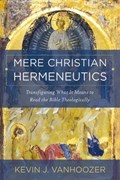Southwestern Journal of Theology 2024 Book of The Year • Christianity Today 2024 Theology Book Award • The Gospel Coalition 2024 Biblical Studies Book Award
Reading the Bible to the glory of God.
In 1952, C. S. Lewis's Mere Christianity eloquently defined the essential tenets of the Christian faith. With the rise of fractured individualism that continues to split the church, this approach is more important now than ever before for biblical hermeneutics.
Many Christians wonder how to read the text of Scripture well, rightly, and faithfully. After all, developing a strong theory of interpretation has always been presented by two enormous challenges:
In response, influential theologian Kevin J. Vanhoozer puts forth a "mere" Christian hermeneutic—essential principles for reading the Bible as Scripture everywhere, at all times, and by all Christians.
To center his thought, Vanhoozer turns to the accounts of Jesus' transfiguration—a key moment in the broader economy of God's revelation—to suggest that spiritual or "figural" interpretation is not a denial or distortion of the literal sense but, rather, its glorification.
Irenic without resorting to bland ecumenical tolerance, Mere Christian Hermeneutics is a powerful and convincing call for both church and academy to develop reading cultures that enable and sustain the kind of unity and diversity that a "mere Christian hermeneutic" should call for and encourage

